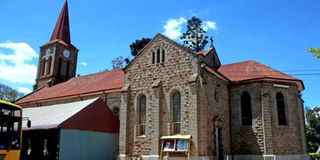Church beats odds to stand strong for 105 years

St Austin’s Catholic Church in Lavington, Nairobi, was opened on October 28, 1914. PHOTO | KANYIRI WAHITO | NATION MEDIA GROUP
What you need to know:
The foundation stone for the church was laid on April 20, 1913. It was built under the supervision of Brother Solanus Zepper.
The church was blessed and opened on October 28, 1914.
The National Museums of Kenya has gazetted the building, which has a capacity for 500 people, as a national monument.
Kikuyu sage Mugo wa Kibiru prophesied about a dangerous serpent that would come from the sea carrying pale-skinned people who would colonise locals and erode their culture.
The community considered the Kenya-Uganda railway the serpent, British administrators the colonists and missionaries spoilers of their culture.
REDEEMED SLAVES
The missionaries, unaware of this divination, used the railway extensively to spread the Good News around the country.
The first Catholic Church in mainland Kenya, St Austin’s Catholic Church in Lavington, Nairobi, tells the tale of interactions between missionaries and the people they found here, the genesis of Arabica coffee in Kenya and how their work led to the spread of the Swahili language.
The story of St Austin’s begins in 1860 with the arrival of the Holy Ghost Fathers, also known as the Spiritans, in Zanzibar.
They were the first Catholic missionaries to arrive on the East African coast. They quickly spread to Bagamoyo in Tanzania, with their mission accepting liberated slaves from naval ships and using their meagre resources to buy slaves from markets in Zanzibar. They then established self-supporting Christian villages, or Liberty Villages, for the redeemed slaves.
VAST PLAINS
The local community was hostile to the villages and although this strengthened bonds among the Christians, it resulted in the deaths of a few missionaries. Eventually, they crossed the border into Kenya, travelling south of the Taita Hills. It was here that they established the Bura Catholic Mission in Mwatate, whose building was completed on 1896. Meanwhile, construction of the railway reached mile 325, in Nairobi, on May 31, 1899. In August of that year, Bishop Emile Allgeyer, with two other bishops from the Holy Ghost Fathers mission in Bura, boarded the train and embarked on a three-day journey from Voi to Nairobi. They set up a tent in the vast plains near where the Nairobi Railway Station stands today. They awoke the next morning to invite any Catholic rail workers within reach for Mass.
That evening Bishop Allgeyer visited their quarters and persuaded them to send a petition to the chief engineer of the Ugandan Railway, Mr Whitehouse, requesting a Catholic church and a house for the priest.
VILLAGE ELDERS
The railway would later be used to transport loads of soil to the new mission, as well as one hundred Arabica coffee seedlings from the Bura mission’s shamba. Their efforts gave birth to the coffee industry in Kenya. The coffee trees planted during this period, however, were taken down in 1945 when the business proved no longer viable.
The trio set off in search of land to build the church. They settled on land on the banks of the Nairobi River offered by a chief named Mzundo. The transaction went against Kikuyu customs, which dictated that no individual should buy land without consulting village elders.
Nonetheless, they built a house with the help of Laibon Lenana, the great chief of the Maasai. They named the station Simonisdale and put it under the patronage of Saint Augustine. Thus began the mission of St Austin of Kikuyu.
THREE SCHOOLS
Later, they negotiated with chief Kinyanjui wa Gathirimu and Laibon Lenana for land. They were granted land in modern-day Muthangari in exchange for five bags of rice. They built their mission on the land and by 1907, 500 families from tribes all over Kenya communed here. They included the Kikuyu, Swahili, Luo, Wachaga from Tanzania, Nandi and Baganda.
At the time, 150 children attended catechism at the three schools on the property. Swahili was established as the language of communication among the community.
The foundation stone for the church was laid on April 20, 1913. It was built under the supervision of Brother Solanus Zepper. The church was blessed and opened on October 28, 1914.
ANCIENT CLOCK
The National Museums of Kenya has gazetted the building, which has a capacity for 500 people, as a national monument.
The towering spire on the facade carries an ancient clock that no longer ticks, for lack of spare parts.
At the main entrance one is greeted by wooden cabinets where a Bible, hymn books and other liturgical paraphernalia are kept. Like any other Catholic church, the altar has a big crucifix inscribed “INRI”.
CCTV CAMERAS
A sculpture of Mary Mother of Jesus and disciples hang across the walls.
The church has been modernised — fitted with CCTV cameras, screens for projecting church proceedings and assorted flowers, not to forget modern paintings.
It is open to the public for Sunday Mass, besides being regularly used for worship by students of St Mary’s School.
Is there a site you want us to feature? Write an e-mail to [email protected]






